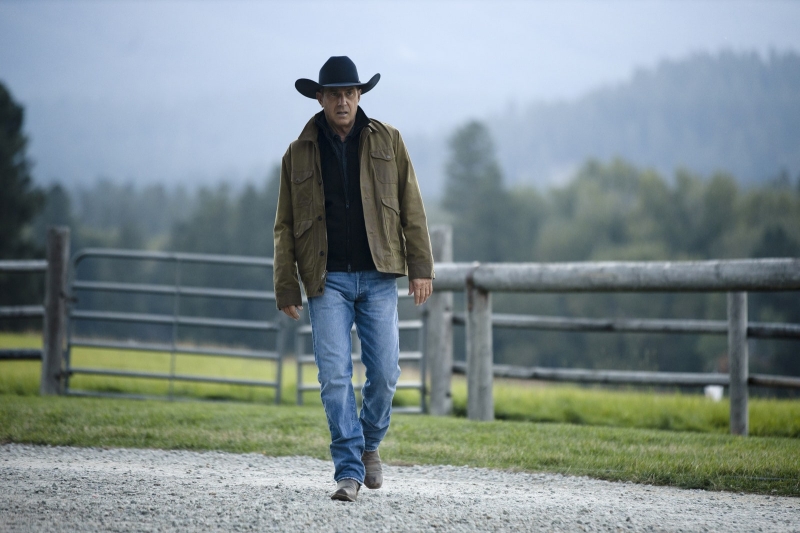If a piece of clothing looks too new on Yellowstone, America’s most-watched television series, now in its fifth season, costume designer Johnetta Boone puts it through a cement roller. Or scorches it with a heat torch. Or roughs it up with sandpaper. Anything that she thinks will give the item a certain patina. Why? Because the show’s characters simply wouldn’t be wearing stuff straight from the store. They would be wearing things they’d already owned for years.
For the uninitiated: The characters in question are members of the powerful Dutton family, who own the largest ranch in Montana and will do anything to keep it, and the people who work on said ranch. The simplest and most authentic word for the latter? Cowboys. Real, modern cowboys who sleep in a crowded bunkhouse and spend their days riding horses, herding cattle, and driving Ford F-150 pickups to keep the Duttons’ property going.
Yellowstone may be a fictional show, but it purports to represent a very real subset of arguably endangered American society: those who live and work in the high, dry, western United States. Boone has dedicated much of the last six years to studying the way such people wear their clothes, and applying her learnings to the series. “Western style is defined by hard work,” she says. Recreating it hinges on nailing down the smaller things: true cowboys, for example, wear jeans way longer than the average American man or woman. “Your typical length on a pair of blue jeans if you are 5’10 is 32 inches—but they wear 38-inch length jeans,” she explains. Why? Because jeans ride up when one rides a horse…and no one wants the top of their boot to show.
Then there are the hats. While many sold in contemporary stores are made of fashion-forward felt, working hands need a style that is waterproof. Hats made of beaver pelt, Boone explains, are considered heirloom items—the kind of thing the wealthy Dutton family would have.
The final piece of the puzzle? “You’ve got to wear not just any shirt, but a shirt with a western yoke and generally pearl snaps,” Boone says. They should also have flap pockets to keep things from falling out.

Suits and formal wear aren’t much of a priority. Even John Dutton—the powerful patriarch of the Dutton family who (spoiler alert) becomes governor of Montana and is later killed by his adversaries—doesn’t have much use, or time, for a closet full of suits. “His suits wouldn’t fit him perfectly,” Boone says. “He’s going to wear the suit that he’s had in his closet for the past five to 10 years, and he’s going to keep that for 10 to 15 years. He’s not going to ride into town to have his suits tailored spot-on to every single measurement,” Boone says. Watch Dutton (played by Kevin Costner) closely, and you’ll realize his suits are always a little baggy—especially when compared to the slick New York businessman who fly into Montana with the hope of making billions developing the land.
Boone sources much of Yellowstone’s clothing from local stores in Montana, including consignment shops and the boutique Double H Hats in Darby. If she needs to go beyond the state border, she looks at brands like Filson, Levi’s, and Carhartt. “It’s a working brand,” she says of the latter. "Carhartt’s [jackets and jeans] were built for coal miners and then adopted into the cowboy culture because it’s so rigid and it can take just about anything.”
John Dutton’s daughter, Beth (Kelly Reilly), a ruthless financier by day and gentle rancher’s daughter by night, is the only central character remotely interested in designer clothing. Boone often dresses her in Max Mara power suits for work—a symbol of Beth’s acceptance and excellence within her field—and flowy prairie dresses from Dôen when she’s home. In fact, she credits the explosively popular show for ushering that style back into the mainstream: “You could hardly find a dress before Yellowstone was out,” Boone says.

Indeed, western style has been trending in high fashion lately—Miu Miu sells bandana-print skirts and tops, Maison Margiela’s made Tabi cowboy boots, and Chloé has doubled down on fringed jackets. “I love the fact that the larger brands are leaning towards celebrating western cultures—it does bring another sense of humanity to all of it,” she says. “The difference is, because it is glamorized, it’s a bit unattainable for your working cowboy and cowgirl.” She points to Pharrell’s fall 2024 collection for Louis Vuitton—which featured real Oklahoma cowboys on the runway and in ad campaigns—as an especially tasteful homage.
After embedding herself in the culture’s style, Boone can understand why it’s been a perennial source of inspiration for brands both at home and abroad. “The epitome of western—and what everyone is most attracted to—is that the culture takes us back to what it was like when things were simple,” she says.

